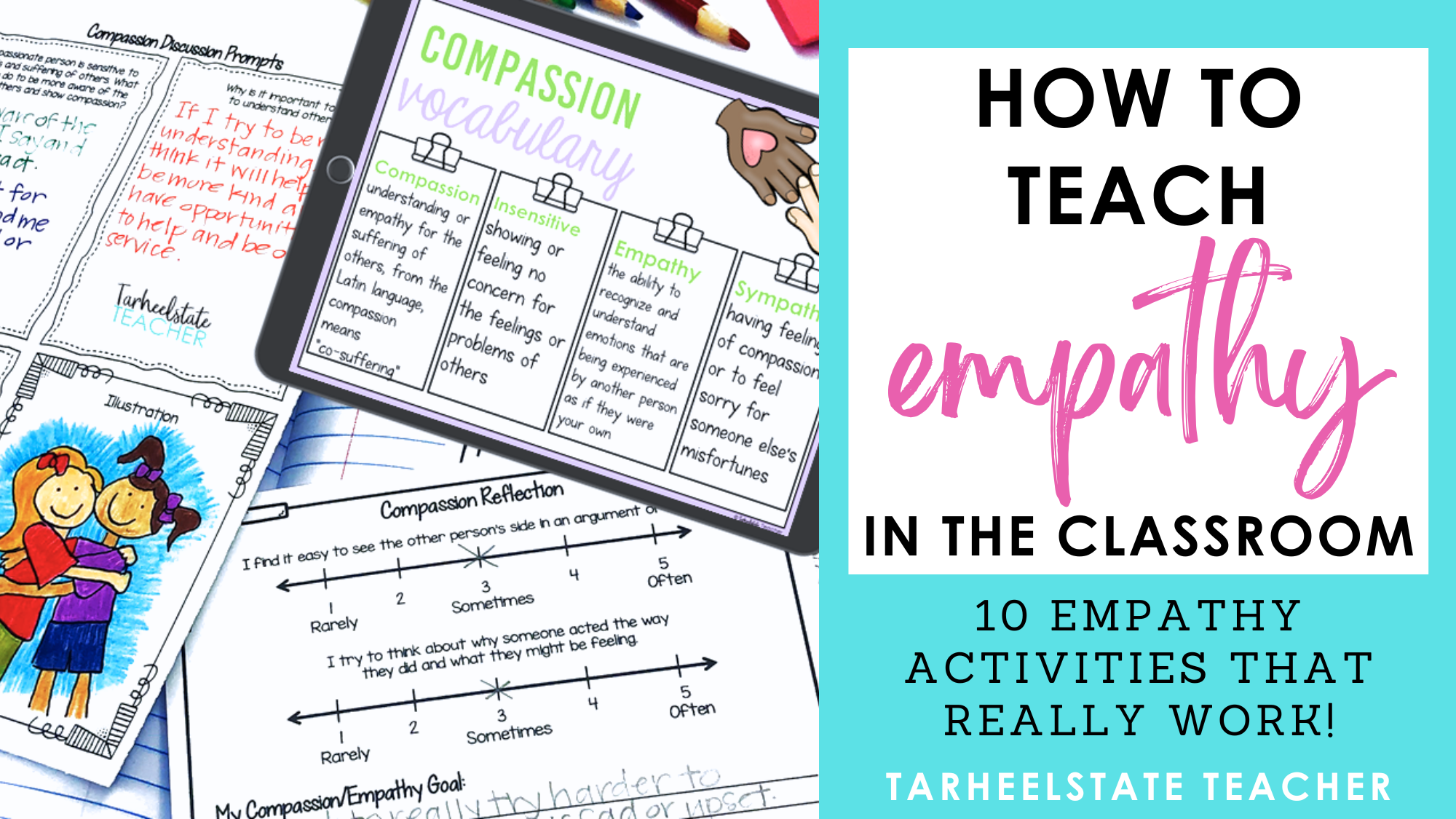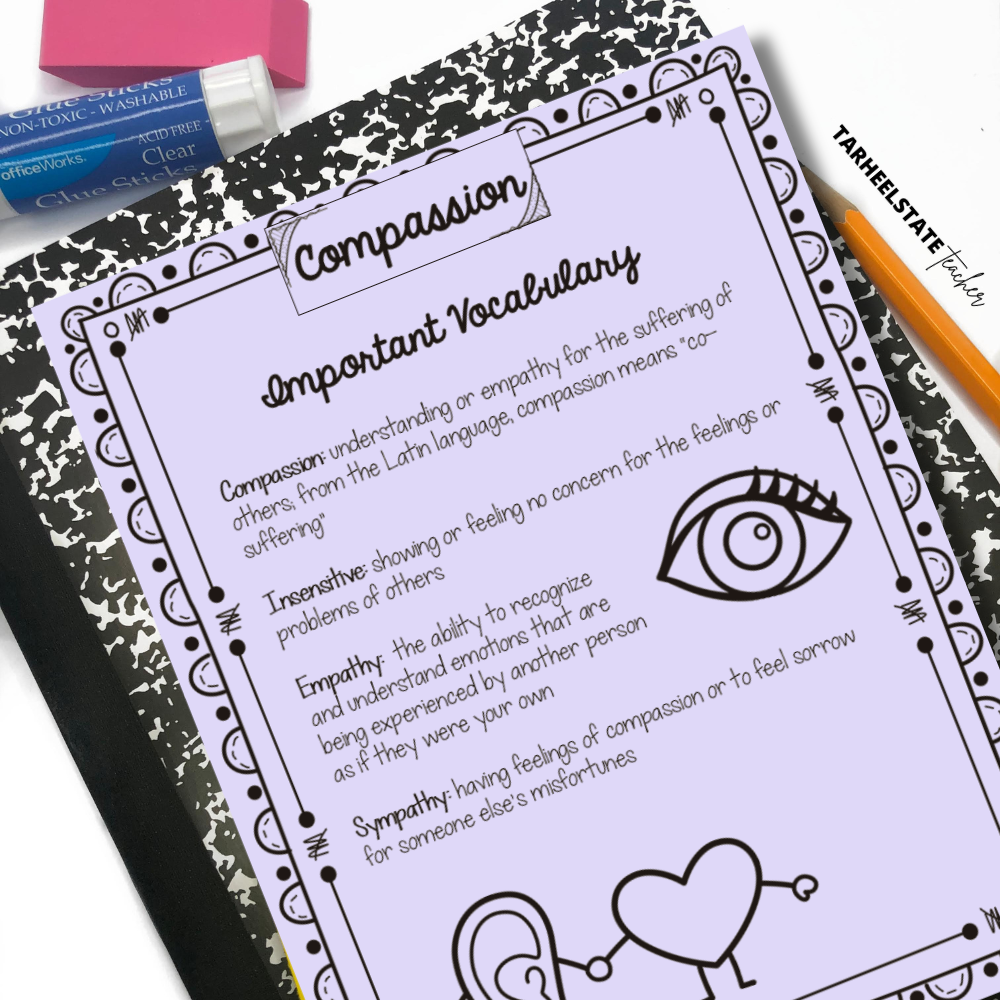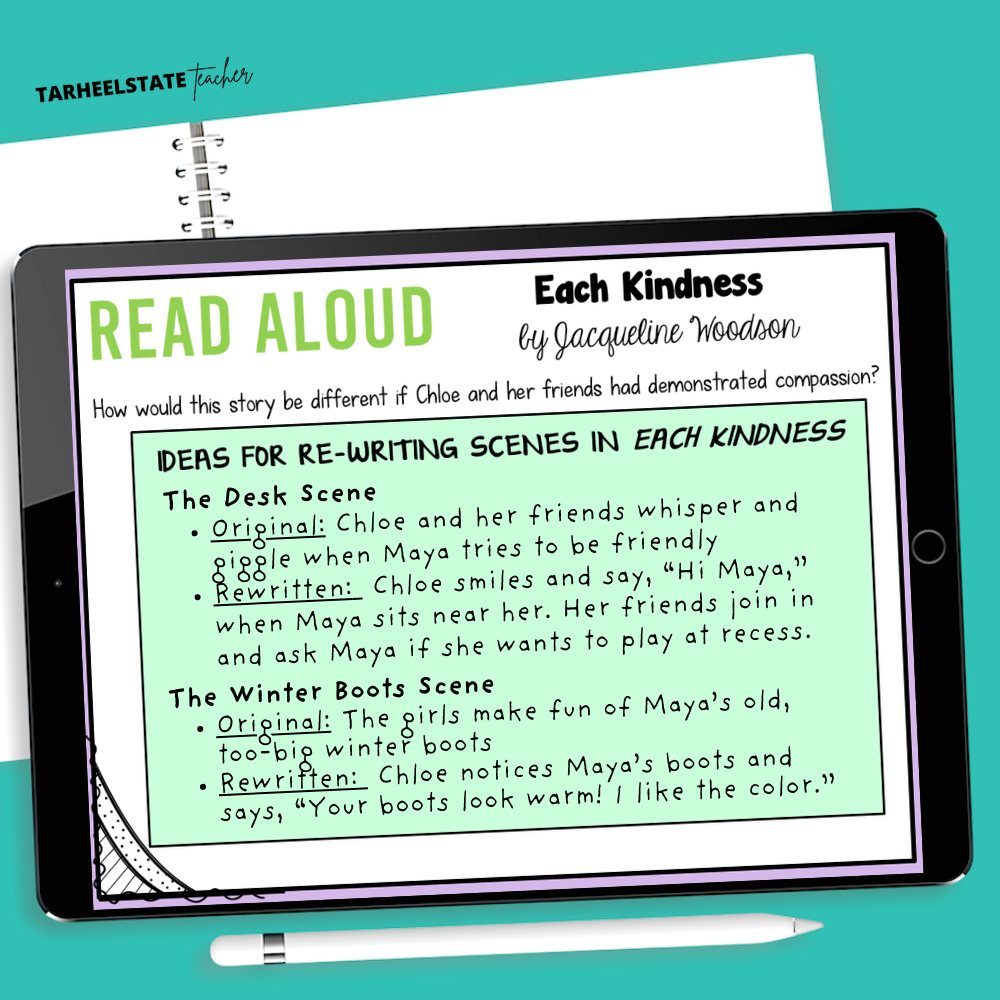How to Teach Empathy in the Classroom: 10 Empathy Classroom Activities That Really Work
Having empathy—and knowing how to express it—is one of the most powerful tools we can give our students. Teaching empathy to students doesn’t just help them understand the feelings of others; it creates a more compassionate, inclusive classroom community. When students learn to recognize different perspectives, respond with kindness, and support their peers, they’re practicing skills that will benefit them for life. These empathy classroom activities and lesson ideas are designed to help upper elementary students move beyond simply knowing what empathy is to actually feeling and showing it. Whether you're using empathy scenarios, engaging in role-play, or encouraging meaningful reflections, these strategies will show you how to teach empathy in the classroom in ways that truly work.
1) TEACH THE VOCABULARY OF EMPATHY
Before students can show empathy, they need to understand what it really means—and how it’s different from similar emotions like sympathy. Start by introducing key terms such as empathy, compassion, perspective-taking, insensitive, and sympathy.
A common question students have is, “Are empathy and sympathy the same?” Helping students explore the definition of empathy vs sympathy allows them to grasp the subtle but important differences between the two.
Empathy is the ability to feel with someone—to put yourself in their shoes and share in their emotional experience. Sympathy, on the other hand, is feeling for someone—acknowledging their pain but from more of a distance. Discussing the empathy vs sympathy definition and meaning gives students the language to describe what they feel and observe in others. One simple way to explain it: sympathy sees the hurt; empathy steps into it. When you give students these tools, you’re laying the foundation for deeper emotional awareness and more authentic connection with others.
2) PROVIDE SELF-REFLECTION OPPORTUNITIES
In my SEL Compassion & Empathy Morning Meeting Unit, I like to use self-assessments and questionnaires that encourage students to reflect on their relationship with empathy and compassion—how easily they recognize the emotions of others and how they typically choose to respond. We also take time to set both personal and whole-class goals related to practicing empathy and compassion, whether it’s through offering support, being a good listener, or trying to understand someone else’s point of view.
3) TEACH THE 4 QUALITIES OF EMPATHY
One of the most powerful ways to help students understand and practice empathy is to explicitly teach them what it looks like in action. In my classroom, we take time to explore the 4 Qualities of Empathy inspired by Brene Brown’s work:
The ability to take the perspective of another person
Refraining from judgment
Recognizing the emotion in another person
Communicating that emotion back to the person
After watching Brene Brown’s short video on empathy, we walk through each of the four qualities together, breaking them down with real-life examples and student-friendly language. I make sure my students can explain each quality and identify how it might look in our classroom, during recess, or at home.
4) MODEL AND PRACTICE EXAMPLES OF EMPATHY STATEMENTS
Many students struggle to find the right words to say in emotionally charged moments, especially when a friend is upset or something hard has happened. That’s why it’s important to explicitly model what empathy sounds like—and then give students the chance to practice using it.
Begin by displaying an example of an empathy vs sympathy statement:
"I can see that you are really sad about that. I’m here for you."
"That’s too bad. I hope things get better soon."
Ask students to discuss:
➡️ What do you notice about the difference between these two comments?
➡️ Which one feels more supportive? Why?
Then, display an Empathy vs Sympathy Chart to help clarify the distinction. Emphasize that empathy involves listening, understanding, and emotionally connecting with others—while sympathy can sometimes sound like pity or dismissal (even when well-intentioned).
Next, divide students into small groups and ask them to sort examples of empathy statements. Each group sorts cards into two categories: Empathy or Sympathy. After sorting, come back together to discuss:
How did you decide where each comment belonged?
Which types of comments make someone feel more understood and supported? Why?
This empathy classroom activity not only builds emotional awareness but gives students real practice in identifying and using compassionate language. Over time, they’ll become more confident and thoughtful in how they respond to others.
5) ANALYZE QUOTES ABOUT EMPATHY
Provide students with quotes on empathy and compassion to analyze and uncover big ideas about what it means to truly understand and care for others. I weave inspiring quotes about empathy throughout my SEL Compassion & Empathy Unit to spark thoughtful discussions and help students reflect deeply on these themes.
I love using quotes because they’re versatile—they can launch a new topic, kick off a quick ten-minute discussion, or serve as a meaningful way to wrap up and reflect on big ideas we've explored together.
6) READ ALOUD PICTURE BOOKS ABOUT EMPATHY
Incorporate children’s literature and picture books about empathy that touch on themes like understanding others’ emotions, perspective-taking, compassion, and the difference between empathy and sympathy. Some of my favorites are The Rabbit Listened by Cori Doerrfeld, The Boy and the Whale by Mordicai Gerstein, and Each Kindness by Jacqueline Woodson. You can click here if you need more recommendations for picture books about empathy and compassion!
🌟After reading a variety of picture books empathy, one of my favorite follow-up activities is a story revision of Each Kindness. We explore the question, “How would this story be different if Chloe and her friends had demonstrated compassion?”
I give students copies of key scenes from the book—especially moments when Chloe and the other girls missed an opportunity to show empathy or extend a sense of belonging. In small groups, students brainstorm how the characters could have responded differently. What could Chloe have said or done to make Maya feel seen and included?
Then, students re-write the scene with these new, more compassionate actions and dialogue. When groups share their versions of the story aloud, it sparks thoughtful conversation about emotional courage and how our small choices can make a big impact on others.
This activity not only deepens comprehension but invites students to reimagine their own roles in peer interactions—empowering them to be active, empathetic members of the classroom community.
7) SURROUND STUDENTS WITH EXAMPLES OF SHOWING EMPATHY
To help students internalize the meaning and importance of empathy, it’s essential to immerse them in real life examples of empathy. One of the most effective ways I’ve found to do this is by using perspective taking and empathy scenarios for teaching about compassion during morning meeting or partner work.
In small groups or with a partner, students choose a few examples of showing empathy model cards and work through a series of thoughtful reflection questions that help them recognize and articulate what empathy looks like in real-life situations. Some of the questions we explore include:
What action was taken to show compassion and empathy to another person?
How do you think both people in the situation felt?
What are other ways the person could have shown compassion and empathy?
🌟This activity leads to meaningful discussions where students begin to see empathy as something they do—not just something they feel. It helps them understand that recognizing another’s emotion and taking perspective is only the beginning; it's the choice to respond with care and understanding that turns empathy into action. Check out my Perspective Taking and Empathy Scenarios here.
8) SHOW EMPATHY VIDEOS
Video is a powerful tool for introducing social-emotional concepts to students—especially when it comes to capturing real moments of empathy, emotional awareness, and compassion in action. In my SEL Compassion & Empathy Morning Meeting Unit, I’ve included a curated playlist of videos that help students see what empathy looks like across different situations and settings.
One of my absolute favorites is the Junior Soccer World Challenge video from 2016. It captures a heartfelt moment after Japan loses to Barcelona. Instead of celebrating wildly, the Barcelona players take the time to console the devastated Japanese team—offering gestures of comfort and support. It’s a powerful example of showing empathy, compassion, and sportsmanship, all rolled into one.
🌟After watching, we pause to reflect and discuss:
What feelings do you think the Japanese players were experiencing?
What must the Barcelona players have understood to respond in such a compassionate way?
What could a lack of empathy have looked like in that moment? Have you ever seen (or been part of) a situation where empathy was missing?
How does this moment reflect a true and meaningful form of compassion?
By analyzing emotional responses in real-world moments like this, students begin to better understand the depth of empathy—not just as a feeling, but as an action. These video discussions also open the door for students to reflect on their own behavior in peer interactions, on the playground, and even in moments of conflict.
9) CREATE A LISTENING WALL
Empathy begins with listening—and not just hearing words, but truly understanding and being present with someone. One way to help students explore this is by creating a Listening Wall in your classroom.
Designate a bulletin board or tape up a large sheet of butcher paper in a visible spot. Invite students to write or draw examples of what makes them feel listened to. These might include phrases like:
“When someone looks me in the eyes while I’m talking.”
“When someone doesn’t interrupt me.”
“When someone nods or says, ‘I understand.’”
“When someone remembers what I said later on.”
🌟This simple, reflective activity not only builds self-awareness but also encourages students to consider how their own listening behaviors impact others. Over time, the wall becomes a growing collection of student-generated strategies for active listening and emotional connection.
10) CREATE A RECIPE FOR COMPASSION
Help your students explore the heart of empathy and care by creating their own imaginative Recipe for Compassion. This fun, reflective activity encourages students to think deeply about the core ingredients that make someone truly compassionate.
Start by having students brainstorm what “ingredients” are needed to show compassion toward others. Their lists might include things like kindness, concern for others, being a good listener, thoughtful actions, asking someone how they feel, patience, offering support, or showing love.
Once students have gathered their ingredients, guide them in writing out the steps of their recipe. Encourage them to be playful and expressive by using cooking-related verbs like “stir,” “mix in,” “blend,” “fold gently,” or “sprinkle.”
🌟This activity is a great way to reinforce the idea that compassion isn’t just a feeling—it’s something we do. By “cooking up” their own compassionate responses, students internalize the small, daily choices that help build a more understanding and caring classroom.
NEED MORE EMPATHY ACTIVITIES AND DONE-FOR-YOU RESOURCES FOR TEACHING COMPASSION?
You can manage to do each of these activities with a reflection journal and materials you have around the classroom, but if you want some of the work done for you, you can check out my Compassion & Empathy SEL unit. I use this unit for a 2-3 week morning meeting unit. It includes student journal pages, detailed and editable compassion and empathy lesson plans, bulletin board materials with compassion vocabulary and related empathy quotations, and Google Slides for the teacher and a digital student notebook. This Compassion & Empathy theme SEL unit is also included in the SEL Morning Meeting MEGA Bundle that contains 16 social- emotional learning themes. If you’re looking to increase your social-emotional learning focus, you’ve come to the right place!
SEL THEMES TO GUIDE YOUR MORNING MEETINGS ALL YEAR
This Compassion & Empathy themed SEL unit is also included in the SEL Morning Meeting MEGA Bundle that contains 16 social-emotional learning themes. With units focused on gratitude, empathy and compassion, growth mindset, conflict resolution and compromise, grit and perseverance, responsibility, understanding and managing emotions, and so much more, your engaging SEL or morning meeting plans are done for you and your students will love them!
If you purchase the bundle from my personal website store, you can save an additional 20% on the SEL Mega Bundle of all 16 topics with the code SEL20.














